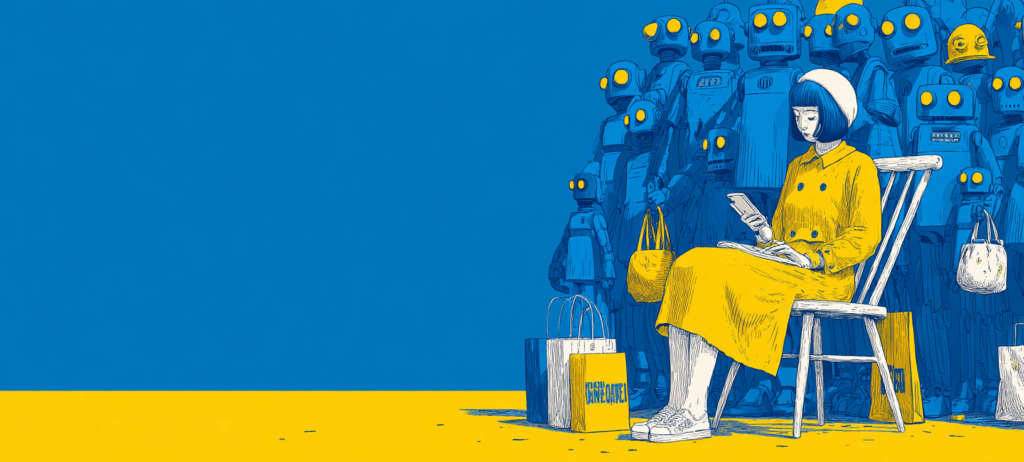-
 Published: Oct 1, 2025
Published: Oct 1, 2025
-
 10 min. read
10 min. read
-
Summarize in ChatGPT
-
 Trevin Shirey
Trevin Shirey VP of Marketing
VP of Marketing
- Trevin serves as the VP of Marketing at WebFX. He has worked on over 450 marketing campaigns and has been building websites for over 25 years. His work has been featured by Search Engine Land, USA Today, Fast Company and Inc. Read his review of working with WebFX for the last 15 years.
Table of Contents
- What is ChatGPT Instant Checkout, and how does it work?
- Why ChatGPT Instant Checkout is a huge win for consumers
- The invisible gatekeeper problem (and why transparent ChatGPT ads are coming soon)
- How does ChatGPT instant checkout tackle reviews?
- What ecommerce companies should do right now
- What B2B and service companies need to understand
- FAQs about ChatGPT Instant Checkout
- Own your spot in the agentic commerce era
- What is ChatGPT Instant Checkout? ChatGPT Instant Checkout is OpenAI’s new feature that allows 700 million weekly users to purchase products directly within the chat interface without leaving the app, powered by the Agentic Commerce Protocol developed with Stripe.
- How does the product recommendation system work? ChatGPT surfaces three to five highly curated product recommendations ranked by relevance rather than showing paginated results, meaning products not in the top handful of recommendations literally don’t exist in that purchase journey.
- What’s the invisible gatekeeper problem? While OpenAI claims product results are organic and unsponsored, ChatGPT considers whether Instant Checkout is enabled when ranking merchants selling the same product—creating hidden commercial incentives since OpenAI generates revenue from these transactions.
- How does ChatGPT handle product reviews? ChatGPT currently pulls quality signals from across the web including manufacturer descriptions, tech blog reviews, and Reddit threads, lacking the concentrated verified review database that gives platforms like Amazon a competitive advantage.
- What should ecommerce companies do now? Merchants using Shopify, Etsy, or Stripe should treat this as a low-regret pilot opportunity—implementation can be as simple as one line of code, and early adopters can learn platform dynamics while building advantages that compound over time.
Here’s how product discovery worked for the last two decades: You searched for “comfy athletic shorts”, and Google showed you 20+ options. You opened eight tabs. You compared features, read reviews, and checked prices across sites. You made a decision based on your own research and judgment.
The shopper controlled the consideration set. The shopper did the comparison. The shopper decided which brands even deserved attention.
That era is dead, and we’ve entered the agentic shopping era. This Monday, OpenAI announced that 700 million weekly ChatGPT users can now buy products without leaving the chat interface.
No more 28 tabs of reviews and Reddit threads about shorts. ChatGPT will surface three to five highly tailored, pre-filtered recommendations ranked by what it considers relevant.
No pagination. No “see more results.” Just the AI’s top curated picks. And if a product supports Instant Checkout, users can tap “Buy,” confirm their order, and complete the purchase without ever leaving the chat.
Translation for online retailers: If your product isn’t in ChatGPT’s top handful of recommendations, you don’t just rank lower. You literally don’t exist in that purchase journey.
What is ChatGPT Instant Checkout, and how does it work?
ChatGPT Instant Checkout is OpenAI’s new feature that lets people buy products directly inside ChatGPT without leaving the app. It’s powered by the Agentic Commerce Protocol (ACP), an open standard co-developed with Stripe that allows AI agents, merchants, and customers to securely complete transactions.
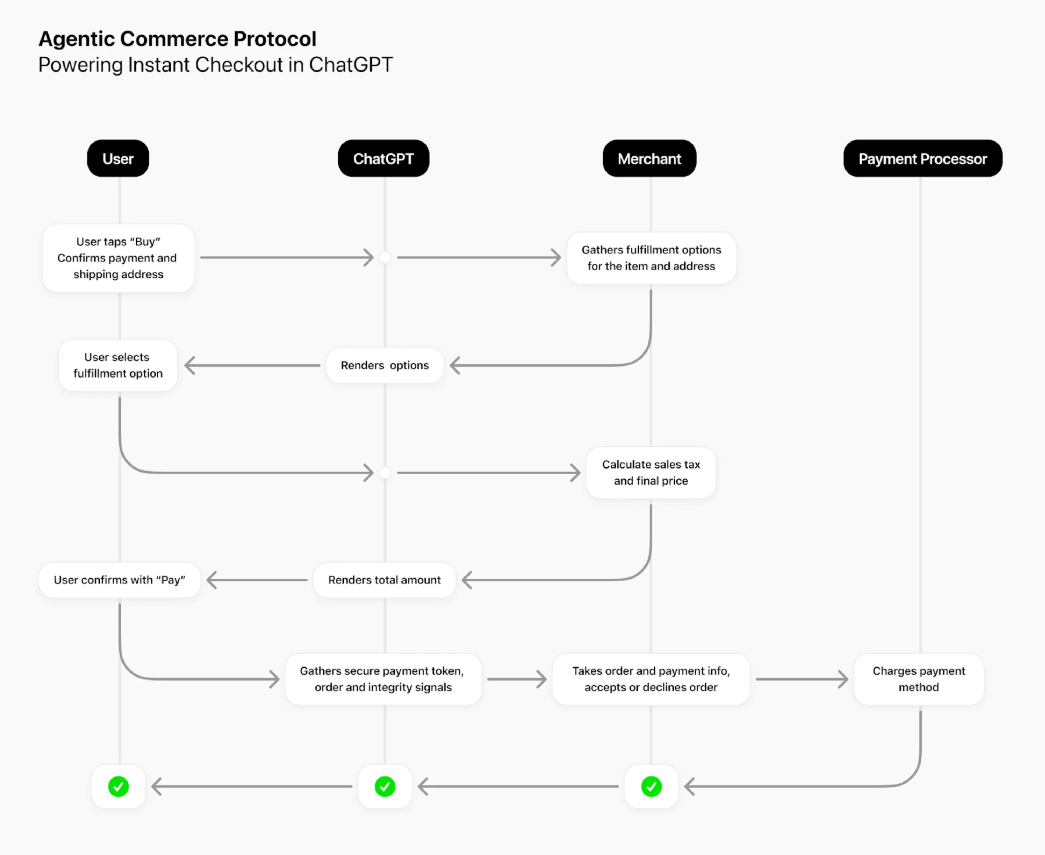
At launch, U.S. users can shop from Etsy sellers, with more than a million Shopify merchants, including Glossier, SKIMS, Spanx, and Vuori, rolling out soon. For now, Instant Checkout supports single-item purchases, with multi-item carts and expanded merchant availability on the roadmap.
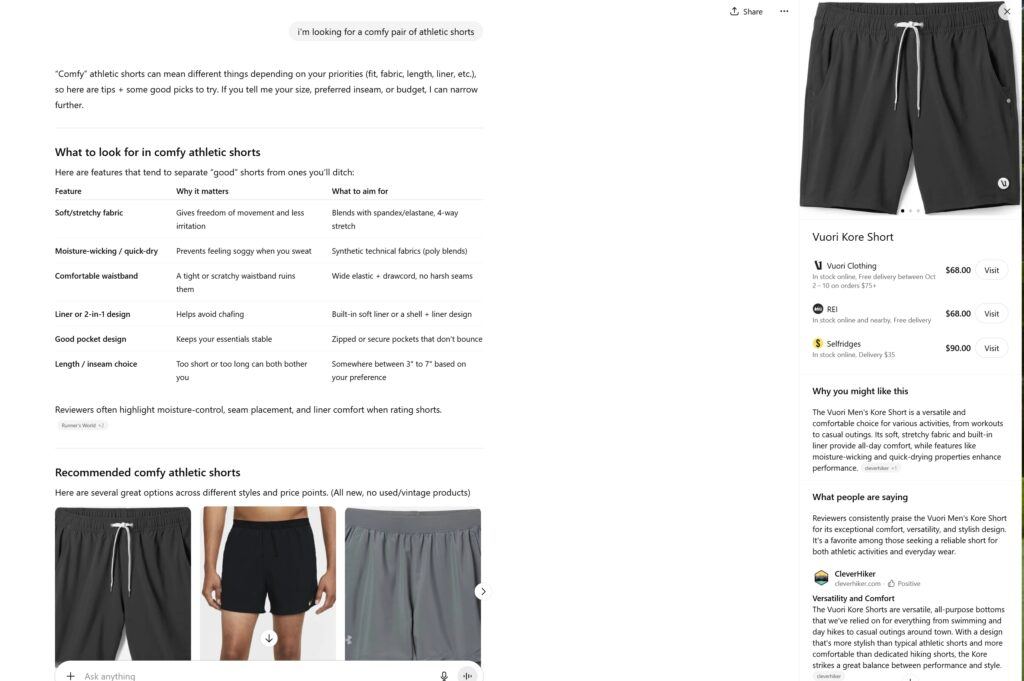
Here’s how it works in practice:
- A user asks a shopping query in ChatGPT, like “best running shoes under $100.”
- ChatGPT surfaces relevant, unsponsored product recommendations ranked by relevance.
- If a product supports Instant Checkout, the user can tap “Buy,” confirm order, shipping, and payment details, and finish the purchase, all without leaving ChatGPT.
- Merchants process the order through their existing systems, keeping control of payments, fulfillment, and customer relationships.
Why ChatGPT Instant Checkout is a huge win for consumers
Let’s acknowledge what OpenAI got right: This is genuinely more convenient for shoppers.
Think about the traditional ecommerce experience: Research on one platform, click through to multiple merchant sites, re-enter payment information, manage different shipping notifications, track orders across various systems. It’s friction at every step (hence the 28 tabs open on our browser during those late-night shopping binges).
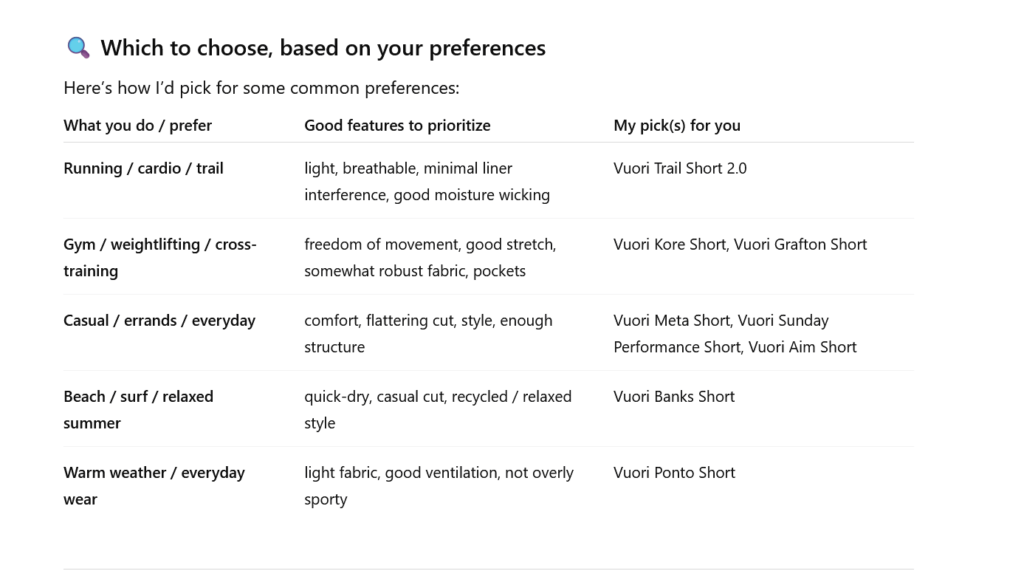
ChatGPT Instant Checkout compresses the whole experience: Research, analysis…all of that. You’re already in the app asking questions. The AI understands context from your conversations. You can buy without context-switching. For consumers, this is a meaningful improvement.
I’ve shared this example before of how much better ChatGPT is at providing simple book recommendations compared to traditional search. Why? It already knows what I like and what we’ve chatted about in the past.
And unlike Google Search, which primarily surfaces what’s been optimized for search engines, ChatGPT can handle nuanced requests that traditional search struggles with:
- “Find unique end tables under $200 from local Seattle retailers”
- “Show me sustainable activewear brands with good labor practices”
- “I need wireless headphones that work well for phone calls, not just music”
The AI can carry context forward from all your conversations. If you told ChatGPT last week that you prefer minimal packaging and have wide feet, it can factor that into today’s shoe recommendations. Ultimately, it starts the ecommerce funnel with a shopping assistant instead of a search engine.
Imagine this scenario: You’re planning a camping trip. Over several conversations, you’ve discussed the location (Pacific Northwest), the season (October), your experience level (beginner), and your budget constraints. When you finally ask “what tent should I buy?”, ChatGPT doesn’t just surface generic “best tents” results. It recommends 3-season tents suitable for PNW weather, priced within your stated budget, from brands that align with preferences you’ve mentioned across weeks of conversations.
That’s genuinely useful. That’s personalization that goes beyond what cookies and browsing history can accomplish. It also presents an opportunity to buy things directly from ecommerce websites vs. through a platform like Amazon.
Amazon often wins because of the familiar UX and quick shipping. A helpful part of how the Agentic Commerce Protocol works is that it generates transactions directly through a brand’s website. You pay a fee to ChatGPT but avoid Amazon’s marketplace fees (which can reach 15-20% with FBA) and the intense competition of hundreds of sellers offering similar products.
You also get exposure to a huge, fast-growing audience.
According to Similarweb data reported by Modern Retail, ChatGPT already drives:
- 20% of Walmart’s referral traffic (up from 15% just one month prior)
- More than 20% of Etsy’s referral clicks
- 15% of Target’s referral traffic
- 10% of eBay’s incoming traffic
While referral traffic still represents less than 5% of these retailers’ total visits today, that percentage is growing every single month. Working with hundreds of businesses at WebFX, we’ve seen this pattern before: New discovery channels start small, grow exponentially, then become indispensable before most companies even develop a strategy.
So lots of excitement and genuine wins for consumers. But this personal shopping assistant comes with some big asterisks and signals that more commercialization is coming to ChatGPT.
The invisible gatekeeper problem (and why transparent ChatGPT ads are coming soon)
OpenAI states that “product results are organic and unsponsored, ranked purely on relevance to the user,” and that Instant Checkout availability “does not influence product ranking in search results”.
That’s the official line. But here’s where it gets complicated:
When ranking multiple merchants selling the same product, ChatGPT considers factors like “availability, price, quality, whether a merchant is the primary seller, and whether Instant Checkout is enabled” to optimize user experience.
Notice that last factor? Whether Instant Checkout is enabled does influence ranking when comparing merchants. OpenAI is now directly incentivized to surface products from merchants who’ve enabled Instant Checkout…because that’s how they generate revenue.
Ultimately, this is another clear step towards ChatGPT offering native ads on the platform. The reality is that clearly labeled ads might actually be better for everyone than “organic” results with hidden commercial incentives showing up in ChatGPT.
Think about it from the user perspective:
Scenario A (Traditional Ads): You see three organic results, then two clearly marked “Sponsored” listings. You know exactly which recommendations might be influenced by payment.
Scenario B (Current Model): You see five “organic” results, but you have no idea that OpenAI makes money when you buy from some of them and not others. The financial incentives are completely invisible.
Which creates more trust?
From a marketer’s perspective, transparent advertising also makes more sense. If I’m going to pay to appear in ChatGPT recommendations, I’d rather:
- Know exactly what I’m paying for (impressions, clicks, conversions)
- Understand the ranking factors and bidding mechanisms
- Optimize my spend based on clear ROI metrics
- Compete on a level playing field where everyone knows the rules
The current model, where “organic” results are influenced by undisclosed commission structures, creates uncertainty for merchants and users alike. At least with a clearly labeled ad system, we’d know which results are paid placements and could make informed decisions.
How does ChatGPT instant checkout tackle reviews?
Here’s a critical advantage that platforms like Amazon have spent two decades building: Millions of verified customer reviews.
When you search for “wireless headphones” on Amazon, you’re seeing products validated by thousands of (mostly) real customer experiences. Those reviews represent an insurmountable moat for newer platforms.
ChatGPT faces the same challenge. When it recommends products, where do the quality signals come from? Right now, it’s pulling from across the web…manufacturer descriptions, tech blog reviews, Reddit threads, scattered retailer feedback. But is that as valuable as Amazon’s concentrated, verified review database?
This is both a challenge and an opportunity:
The challenge: ChatGPT recommendations lack the social proof that drives purchase confidence. Without rich review data, how do users trust the AI’s suggestions?
The opportunity: For merchants, this levels the playing field somewhat. You’re not competing against products with 50,000 Amazon reviews. You’re competing in an environment where reputation signals are still forming.
The platforms that solve the review problem, whether through partnerships, aggregation, or new verification methods, will have a massive advantage in AI commerce. It’s one of the most important unsolved problems in this space.
What ecommerce companies should do right now
If you’re selling physical products through Shopify, Etsy, or processing payments via Stripe, here’s the pragmatic approach:
Short-term: Treat Agentic Commerce Protocol like a new distribution channel.
Think of it as discovery + checkout, similar to how you might approach TikTok Shop or Instagram Shopping. It’s another way for customers to find and purchase your products.
Implementing ACP is a low-regret pilot if you already run Stripe, Shopify, or Etsy:
- Merchants already processing payments with Stripe can enable agentic payments in as little as one line of code
- The implementation complexity is minimal
- You maintain control of fulfillment, customer service, and operations
- The downside risk is limited (just the transaction fees)
- The upside could be significant if ChatGPT commerce takes off
It’s similar to the early days of Amazon Marketplace. Not every merchant needed to join immediately, but the ones who piloted early learned the platform dynamics and built advantages that compounded over time.
Key questions to evaluate:
- Does your target customer use ChatGPT for product discovery?
- Are your margins healthy enough to absorb 3-5% platform fees?
- Can your existing systems handle orders from a new channel?
- Do you have competitors already experimenting with this?
If the answers are mostly “yes,” running a 90-day pilot makes strategic sense. If they’re mostly “no,” monitoring the space while focusing on core channels is equally valid.
What B2B and service companies need to understand
You might be thinking: “We sell enterprise software, not yoga pants. Why does this matter?”
Here’s why:
First, AI-mediated discovery affects every category. Even if your prospects never complete a purchase in ChatGPT, they’re increasingly using it to research vendors, compare solutions, and build consideration sets. When a CFO asks ChatGPT “best accounting software for mid-market manufacturing companies,” which three solutions get recommended?
Second, this is about visibility strategy, not just transactions. The companies that appear in AI agent recommendations build mindshare and credibility…even when the actual sale happens through traditional channels.
Ultimately, purchasing directly within ChatGPT is a genuine convenience win for consumers. It’s a meaningful discovery improvement over traditional search. And it’s a fundamental shift in how visibility works for marketers.
FAQs about ChatGPT Instant Checkout
What is ChatGPT Instant Checkout?
ChatGPT Instant Checkout is OpenAI’s new feature that lets people purchase products directly inside ChatGPT. Instead of clicking out to multiple merchant sites, users can browse recommendations and complete their order in the same conversation. The system is powered by the Agentic Commerce Protocol (ACP), co-developed with Stripe, which securely connects AI agents, merchants, and customers to finalize transactions.
How does ChatGPT Instant Checkout work?
When you ask a shopping question in ChatGPT like “best gifts for a ceramics lover”, the AI shows relevant, unsponsored product recommendations. If a product supports Instant Checkout, you’ll see a “Buy” button. You confirm order, shipping, and payment details in-chat, and the merchant fulfills the order through their existing systems.
Who can use ChatGPT Instant Checkout today?
As of launch, U.S. ChatGPT Plus, Pro, and Free users can shop from Etsy sellers. OpenAI plans to expand support to more than one million Shopify merchants, including brands like Glossier, SKIMS, Spanx, and Vuori, in the coming months.
Does ChatGPT favor products with Instant Checkout?
OpenAI says product results are ranked by relevance, not payment. However, when multiple merchants sell the same product, factors like price, quality, availability, whether a merchant is the primary seller, and whether Instant Checkout is enabled all influence rankings. That means enabling Instant Checkout could make your listing more competitive.
Is ChatGPT Instant Checkout available outside the U.S.?
Not yet. At launch, it’s limited to U.S. users. OpenAI has confirmed plans to expand to additional regions and merchants in future rollouts.
How secure is ChatGPT Instant Checkout?
OpenAI built ACP with trust in mind. Payments use encrypted tokens that only authorize specific amounts with user permission. Merchants receive only the data needed to complete the order, and users confirm every step before a purchase goes through.
What fees apply to merchants?
ChatGPT Instant Checkout is free for users. Merchants pay a small transaction fee on completed purchases, though OpenAI has not disclosed exact percentages. Industry observers expect fees in the range of 3–5%, similar to other marketplaces.
What does ChatGPT Instant Checkout mean for ecommerce businesses?
For sellers, it’s a new distribution channel with access to 700 million weekly ChatGPT users. But it also creates challenges: Attribution gets murkier, product data quality becomes as critical as SEO, and merchants trade some brand control for scale. Early adopters may gain an edge, just as businesses that optimized for mobile or Amazon did before their competitors.
Own your spot in the agentic commerce era
ChatGPT Instant Checkout marks the start of agentic commerce, where discovery, decision-making, and purchase collapse into one seamless flow. For shoppers, it’s an instant convenience. For businesses, it’s a visibility test: If you’re not showing up in AI-powered recommendations, you’re invisible at the point of sale.
The businesses that move first don’t just participate in this shift. They set the standard for it. At WebFX, our generative engine optimization (GEO) services are built to help you capture that first-mover advantage.
Ready to claim your space in the AI-driven buying journey? Contact us online or call 888-601-5359 today to see how our high-impact GEO services can future-proof your growth.
-
 Trevin serves as the VP of Marketing at WebFX. He has worked on over 450 marketing campaigns and has been building websites for over 25 years. His work has been featured by Search Engine Land, USA Today, Fast Company and Inc. Read his review of working with WebFX for the last 15 years.
Trevin serves as the VP of Marketing at WebFX. He has worked on over 450 marketing campaigns and has been building websites for over 25 years. His work has been featured by Search Engine Land, USA Today, Fast Company and Inc. Read his review of working with WebFX for the last 15 years. -
 Albert Dandy Velasquez blends SEO strategy with compelling storytelling to help businesses boost their visibility and revenue online. With a B.A. in English and certifications from HubSpot, Semrush, and Google Analytics, he has written and optimized hundreds of articles on organic SEO, content strategy, and user experience. He regularly contributes to the WebFX blog and SEO.com, creating content that helps readers turn marketing goals into measurable results. When he’s off the clock, he’s usually exploring new neighborhoods on two wheels, filming travel content, or chasing golden hour with a coffee in hand.
Albert Dandy Velasquez blends SEO strategy with compelling storytelling to help businesses boost their visibility and revenue online. With a B.A. in English and certifications from HubSpot, Semrush, and Google Analytics, he has written and optimized hundreds of articles on organic SEO, content strategy, and user experience. He regularly contributes to the WebFX blog and SEO.com, creating content that helps readers turn marketing goals into measurable results. When he’s off the clock, he’s usually exploring new neighborhoods on two wheels, filming travel content, or chasing golden hour with a coffee in hand. -

WebFX is a full-service marketing agency with 1,100+ client reviews and a 4.9-star rating on Clutch! Find out how our expert team and revenue-accelerating tech can drive results for you! Learn more
Try our free Marketing Calculator
Craft a tailored online marketing strategy! Utilize our free Internet marketing calculator for a custom plan based on your location, reach, timeframe, and budget.
Plan Your Marketing Budget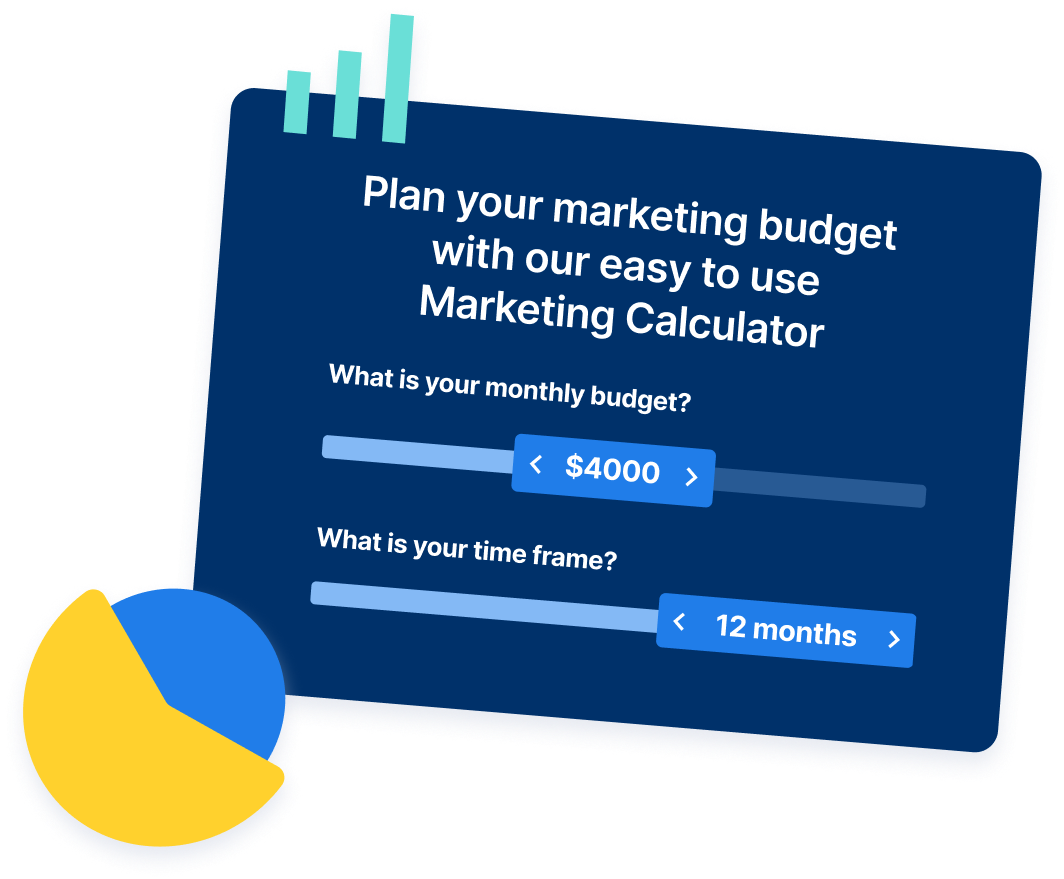
Table of Contents
- What is ChatGPT Instant Checkout, and how does it work?
- Why ChatGPT Instant Checkout is a huge win for consumers
- The invisible gatekeeper problem (and why transparent ChatGPT ads are coming soon)
- How does ChatGPT instant checkout tackle reviews?
- What ecommerce companies should do right now
- What B2B and service companies need to understand
- FAQs about ChatGPT Instant Checkout
- Own your spot in the agentic commerce era
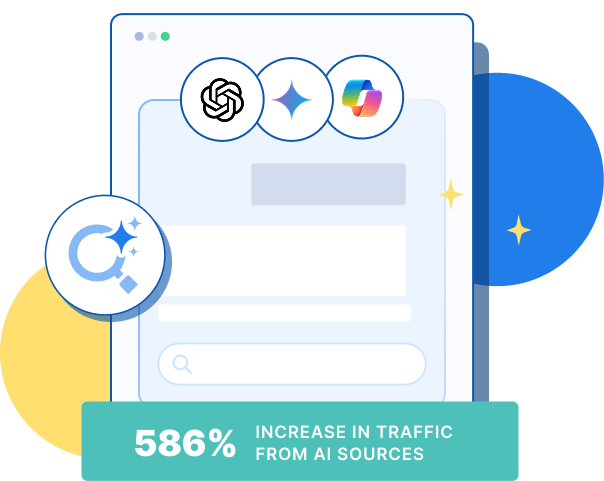
See AI Marketing in Action
Explore how WebFX helped a regional brand get discovered in AI search experiences — proving what’s possible with today’s AI-driven marketing!

Proven Marketing Strategies
Try our free Marketing Calculator
Craft a tailored online marketing strategy! Utilize our free Internet marketing calculator for a custom plan based on your location, reach, timeframe, and budget.
Plan Your Marketing Budget
